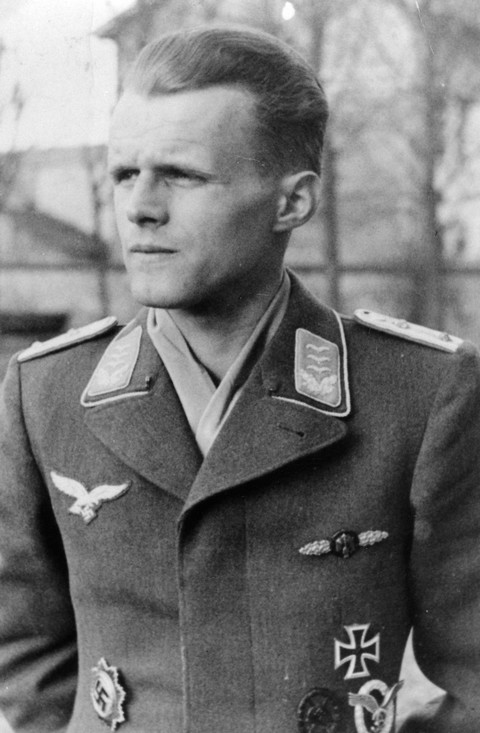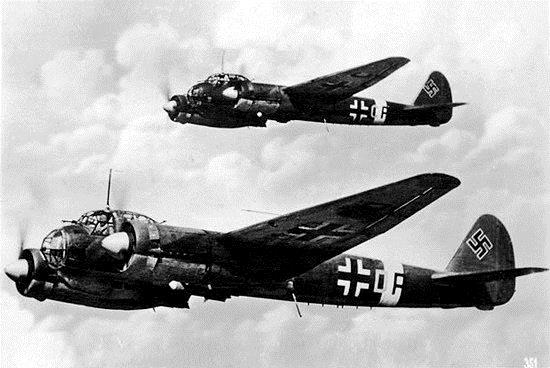LUFTWAFFE OVER RIVINGTON
De Havilland Attack Via Rivington
Former classified documents of
interviews of prisoners of war of the German Luftwaffe
reveal a top
secret bombing raid, its pilots only given the target
details on the morning of the raid, 3rd July
1942, it was flown by Germanys most experienced crews for a
very low altitude attack by two Junkers Ju 88 dive bombers, the
crews had spent a week training, on leaving their base in
occupied France they were flying heavy on minimum fuel,
skimming the waves and just over tree tops carrying on its
wings four 250kg
bombs with 8 second delay fuses and a mixed load of 50kg HE
and 1kg incendiaries and its flight path used the Rivington
reservoirs as navigation at six minutes zero altitude
completing the bombing raid at 60ft.
 The
German squadron was 2nd Staffel of Kustenfliegergruppe 106
based at Dinard / Pleurtuit airfield Brittany, (2nd Coastal
Command Group 106) led by Squadron commander Hans Bergemann,
(left) had persuaded his superior Group Commander Major Ghert Roth that a daytime bombing mission to target the De
Havilland Aircraft factory at Lostock in Bolton was possible,
using the distinctive shape of Rivington reservoir's as a
guide to home in on the target, he was ambitious
and seeking medals. The factory was a major manufacturer of
variable pitch propellers, the main supplier to all the UK
airplane manufacturers, Bergemann was a trusted and
experienced pilot.
The
German squadron was 2nd Staffel of Kustenfliegergruppe 106
based at Dinard / Pleurtuit airfield Brittany, (2nd Coastal
Command Group 106) led by Squadron commander Hans Bergemann,
(left) had persuaded his superior Group Commander Major Ghert Roth that a daytime bombing mission to target the De
Havilland Aircraft factory at Lostock in Bolton was possible,
using the distinctive shape of Rivington reservoir's as a
guide to home in on the target, he was ambitious
and seeking medals. The factory was a major manufacturer of
variable pitch propellers, the main supplier to all the UK
airplane manufacturers, Bergemann was a trusted and
experienced pilot.
The flight inbound was via the Irish
Sea at wave height, toward the Isle of Man, at which point
their presence became known to IOM defenses on detecting
German Elecktra 2 signals.

On detection Royal Observer Corps were now monitoring the bombers. On reaching IOM the bombers turned hard right to the Ribble estuary at 7.45pm, their flight plan was to navigate six minutes at zero feet over Rivington reservoir’s then south, over Horwich rooftops rising to 60ft for the final stage for what would have been a huge bombing raid on De Havilland, Lostock.
By the grace of God unexpected low cloud cover on approach to Rivington caused the bombers to lose direction, taking the mission off course, away from De Havilland, Lostock near Bolton. 25)
Another theory put forward to explain why they went off course was that the bombers used a Luftwaffe map that was wrong, showing De Havilland at Lostock Hall, near Preston,24) however they made land at the Ribble Estuary and their flight path had set off air raid siren's for raid 299 in Manchester, as the bombers headed out on the escape route over Stockport. One of the JU88s crews were all killed, the surviving crew stated very low cloud cover had sent them off course.
The bombers continued on at very low
altitude, Derek Gould, age 16 a fire watcher at Bailey’s
bandage works, saw them flying very low over Hillgate,
Stockport, he said he could see the crews faces, another
witness described how they were “blowing the leaves off
tree’s", now heading toward the Peak District in Derbyshire
where no air raid warning was given, the bombers were now on their escape route toward Schipol.
A boy named John Ingham out playing at Marple ridge
witnessed the JU88s fly low down the valley towards New
Mills, where bombs were
released on mostly civilian targets. The planes were also
equipped with machine guns, that they fired indiscriminately
on civilians homing in on people at low altitude, including
a group of two teams of boys playing junior cricket, firing
at upto a 1000 rounds a minute, after this moving
on to bomb Hayfield, then blowing windows in at Chatworth House, then bombing Darlton Quarry before Spitfires
from 303 Squadron piloted by Polish pilots brought them down
around 8.30pm near Baumber and between Aswardby and
Harrington in
Lincolnshire.

This site is recorded on the Internet
archive, at the link
here.
Copyright Paul Lacey, 2010 All rights reserved.